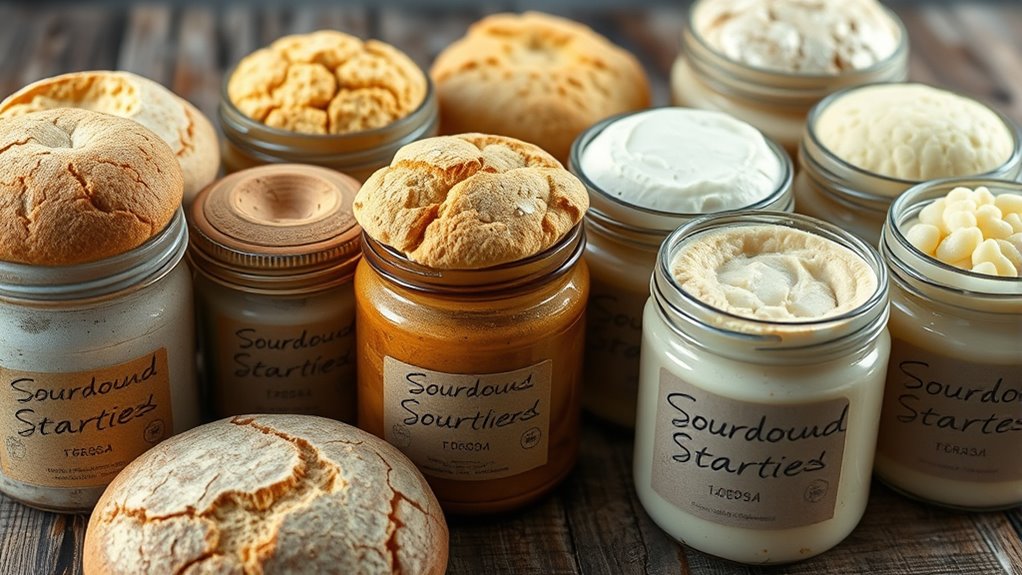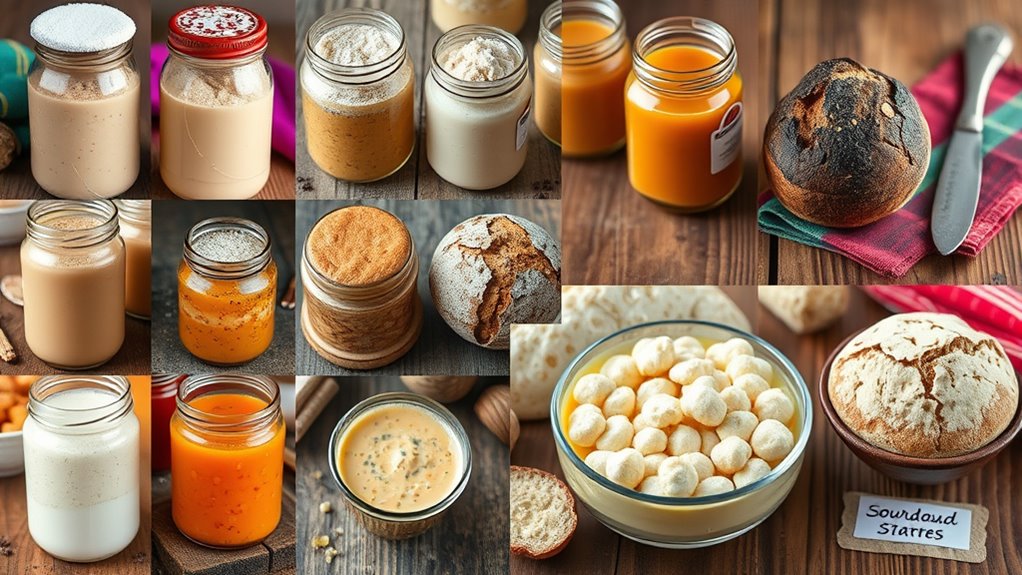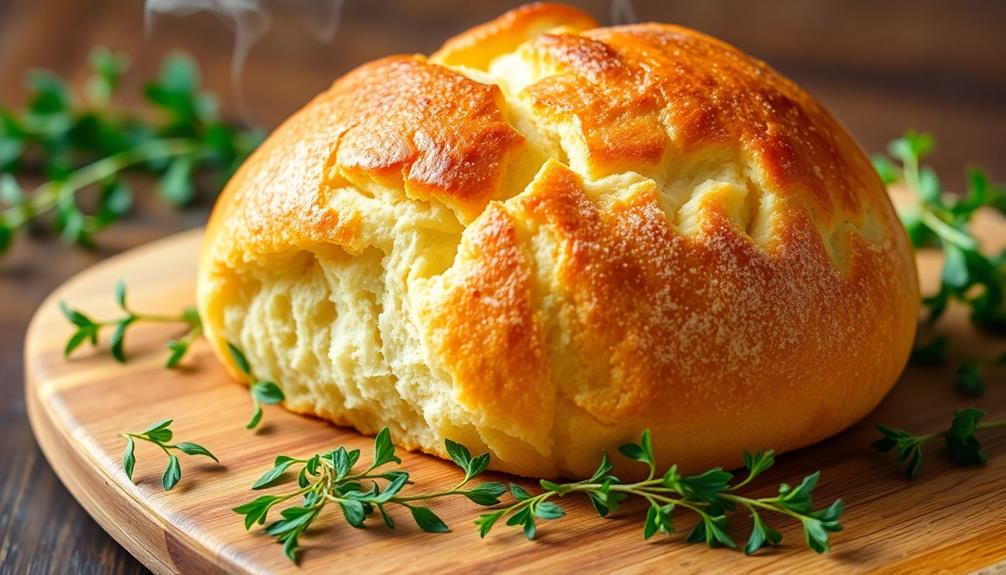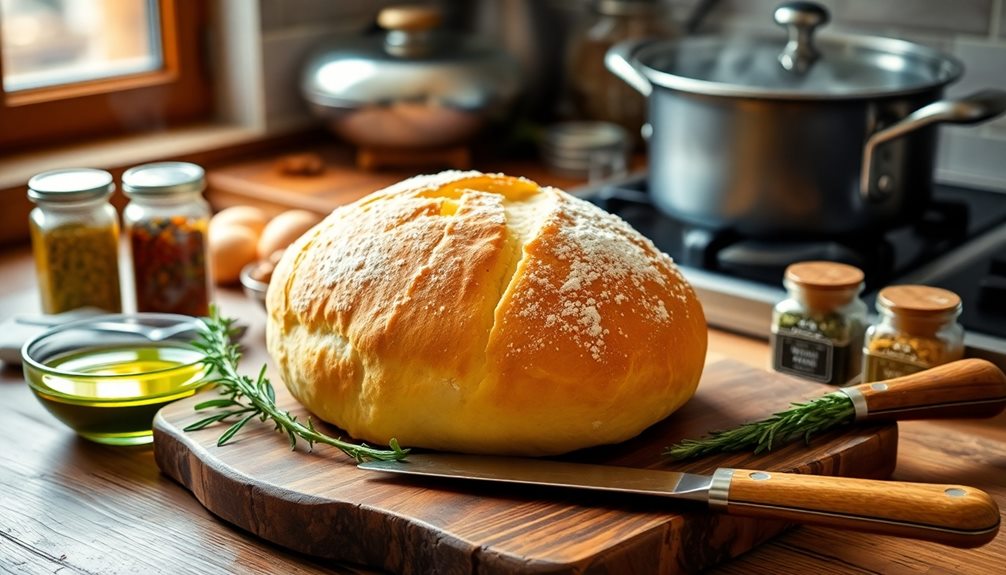Sourdough starters around the world are shaped by their local ingredients, climate, and cultural traditions, giving each a unique flavor and character. European starters rely on slow fermentation and local grains, while East Asian ones incorporate rice or millet. African and Middle Eastern starters often use regional spices, herbs, and indigenous grains. Climate affects fermentation speed and microbial diversity, making each starter distinct. If you explore further, you’ll discover how these traditions create truly one-of-a-kind breads.
Key Takeaways
- Regional ingredients like rice, teff, or millet influence microbial diversity and flavor profiles of starters.
- Climate and environment shape fermentation speed, microbial communities, and resulting bread characteristics.
- Traditional practices and recipes are passed down within cultures, preserving unique fermentation methods.
- Local spices, herbs, and grains impart regional flavors and distinctive textures to starters.
- Cultural history and community sharing contribute to the diversity and authenticity of starters worldwide.

Have you ever wondered how cultures across the globe create their unique bread flavors? It all comes down to the fermentation techniques and cultural influences that shape each sourdough starter. Every region has its own methods for cultivating wild yeasts and bacteria, resulting in distinct flavors and textures. These differences aren’t just about ingredients; they reflect centuries of tradition, climate, and local tastes. When you start exploring sourdough starters from around the world, you’ll notice that each one tells a story about its origin, shaped by the community that nurtures it.
Discover how global cultures craft unique sourdough flavors through tradition, environment, and community.
In many parts of Europe, especially France and Italy, fermentation techniques focus on slow, natural fermentation, often using local grains and water. These methods develop complex flavors as the yeasts and bacteria work together over days or even weeks. The long fermentation not only enhances taste but also breaks down gluten, making the bread easier to digest. Meanwhile, in East Asia, sourdough starters are influenced heavily by local ingredients like rice or millet. These cultural influences introduce unique microorganisms into the starter, giving Asian sourdoughs their characteristic tang and chewy texture. The use of traditional fermentation techniques in these regions often involves specific starter maintenance routines passed down through generations, emphasizing patience and harmony with nature.
In Africa, particularly Ethiopia, the traditional process involves fermenting teff flour to create injera, a sourdough-like flatbread. Here, fermentation techniques are deeply tied to local grains and climate, with warm temperatures accelerating fermentation. These practices are shaped by cultural influences that prioritize communal baking and flavor profiles that balance sourness with sponginess. Additionally, climate plays a significant role in the speed and character of fermentation in different regions, affecting the microbial community and flavor development. The microbial diversity present in each environment further influences the microbial community within the starters, creating regional flavor profiles. Furthermore, the specific fermentation conditions such as temperature and humidity are crucial for achieving the desired flavors and textures in each region’s bread. Similarly, in the Middle East, sourdoughs are crafted with regional spices, herbs, and local grains, which influence the starter’s microbial community. The cultural importance of hospitality and sharing bread means these starters are often passed down within families, ensuring the preservation of traditional methods and flavors.
Across North and South America, indigenous and immigrant communities have brought their fermentation techniques and ingredients, creating a diverse array of sourdough starters. From the sourdoughs of San Francisco, renowned for their tangy profile, to indigenous corn-based starters in Central America, each reflects a blend of tradition and environment. The cultural influences are evident in the way these starters are maintained, fed, and baked, blending old-world techniques with local ingredients.
When you compare these starters, you see how fermentation techniques and cultural influences shape each one uniquely. It’s a living testimony to history, environment, and community, giving each loaf its own character. By understanding these differences, you gain a deeper appreciation for the rich diversity behind every slice of sourdough bread around the world. Additionally, the accuracy of fermentation can significantly impact the flavor and texture of the final bread, highlighting the importance of precise techniques and conditions.
Frequently Asked Questions
How Do Climate Differences Affect Sourdough Starter Fermentation?
Climate differences markedly impact your sourdough starter fermentation. Warmer temperatures speed up fermentation, so you might need to adjust your starter hydration or fermentation temperature to prevent over-proofing. Cooler climates slow down the process, requiring longer fermentation times. By monitoring these factors, you can control how quickly your starter develops flavor and activity. Adapt your hydration level and fermentation temperature based on your environment to achieve consistent, delicious results.
What Are Traditional Ingredients Used in Regional Sourdough Starters?
You might think all sourdough starters share the same ingredients, but regional variations tell a different story. Traditional ingredients include local flours, water, and sometimes unique additions like rye, barley, or millet, which influence starter hydration and fermentation timeline. These regional ingredients shape flavor and activity, making each starter distinct. Don’t overlook how local climates and ingredients create diverse sourdough cultures worldwide, adding depth to your baking experience.
Can Sourdough Starters From Different Countries Be Combined?
You can definitely combine sourdough starters from different countries, but you should consider starter compatibility and flavor blending. Mixing starters may create a unique taste, but it can also cause fermentation issues if the cultures aren’t compatible. To succeed, start with small amounts, observe how the cultures interact, and be prepared for adjustments. This way, you can craft a hybrid starter that balances flavors while maintaining healthy fermentation.
How Do Cultural Practices Influence Sourdough Maintenance?
You’re influenced by cultural practices that shape how you maintain your sourdough starter. Fermentation rituals, passed down through generations, dictate feeding schedules and ingredients, while starter symbolism often reflects local traditions and beliefs. These practices impact the flavor, texture, and resilience of your starter, making it unique to your community. Embracing these cultural influences helps you preserve authentic methods and connect more deeply with your baking heritage.
Are There Unique Health Benefits Associated With Regional Starters?
You might notice regional starters offer unique health benefits due to their fermentation enzymes and probiotic diversity. These starters develop specific bacteria and yeasts influenced by local environments, which can improve digestion and boost gut health. By consuming different regional starters, you get a broader spectrum of probiotics that support your immune system. Embracing these differences allows you to enjoy not just diverse flavors but also enhanced health benefits from each unique sourdough.
Conclusion
So, next time you see a sourdough starter, remember it’s more than just flour and water—it’s a living piece of culture. Some believe starters carry the essence of their region, shaped by local ingredients and climate. While that’s partly true, science shows it’s the unique fermentation process that truly makes each starter one-of-a-kind. Embrace the mystery and history behind your starter—it’s a delicious, living connection to the world’s baking traditions.










